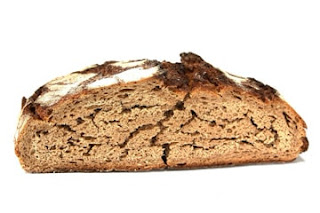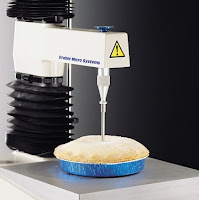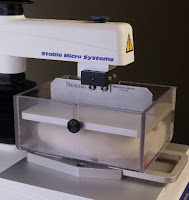Bread
When bread goes stale, the major factor that puts a consumer off is the change in texture, although flavour changes also occur.
When bread goes stale, the major factor that puts a consumer off is the change in texture, although flavour changes also occur.
The textural changes during bread staling, and the processes that drive them, have been outlined in detail in a previous series of blog posts. The exact process of staling is not well understood despite a large amount of research into this topic.
Staling begin s as soon as baking ends, and it becomes detectable to the consumer as early as a few hours after baking. Bread staling presents itself as reduced springiness and reduced crumb softness, both of which can be measured using a firmness measurement with a cylinder probe on a TA.XTplus Texture Analyser.
s as soon as baking ends, and it becomes detectable to the consumer as early as a few hours after baking. Bread staling presents itself as reduced springiness and reduced crumb softness, both of which can be measured using a firmness measurement with a cylinder probe on a TA.XTplus Texture Analyser.
Staling begin
 s as soon as baking ends, and it becomes detectable to the consumer as early as a few hours after baking. Bread staling presents itself as reduced springiness and reduced crumb softness, both of which can be measured using a firmness measurement with a cylinder probe on a TA.XTplus Texture Analyser.
s as soon as baking ends, and it becomes detectable to the consumer as early as a few hours after baking. Bread staling presents itself as reduced springiness and reduced crumb softness, both of which can be measured using a firmness measurement with a cylinder probe on a TA.XTplus Texture Analyser.Additionally, the mouthfeel of both dryness and crumbliness increases, and the crust becomes tougher and less crisp. This change occurs due to moisture movement from the crumb to the crust, but changes to the contained starch molecules are also a major cause.
Cakes
The two most valued textural properties of cake are high moistness and high tenderness. Cakes generally contain less gluten than bread, which gives them a crumblier, less cohesive crumb texture. Additionally, cakes have a more tender bite than bread due to the addition of sugar and fat.
The reduction of either moistness or tenderness during storage will indicate the occurrence of staling. The filling of a cake often spoils before the sponge has had a chance to become stale, but textural changes due to staling do still occur. The mechanism behind this is similar to the staling of bread. However, protein changes and dehydration have more of an effect on the sensory qualities of cake staleness.
Cakes stale in two stages – firming and moisture migration. Firming of the crumb is similar to the process that occurs in bread crumb – it is not related to overall moisture loss, and occurs even when stored in a humid environment. Moisture migration causes the decrease in moistness felt in the mouth. The presence of sugars in cake, particularly glucose, helps to reduce staling, as they slow starch crystallisation and water migration.
Cake firmness can be measured using the AACC standard originally developed for bread firmness. A P/36R probe is used, a 36mm cylinder probe with rounded edges (to avoid cutting the sample around the edges during the test). Two slices of cake are stacked and compressed to a 40% strain, and firmness is recorded as the force at 25% strain.
Biscuits and Crackers
To have good consumer acceptance, biscuits and crackers must have high crispness. This is characterised by high stiffness and low toughness in the mouth, giving a ‘snap’ when bitten into. Additionally, multiple large acoustic events occur. Biscuits tend to have a higher fat content than crackers, giving the two products differing microstructures. However, they should have similar acoustic and mechanical fracture properties.
Unlike wet-crisp foods (e.g. carrots), dry-crisp foods such as crackers lose their crispness when they gain moisture. If a biscuit packet is left open, especially in a humid environment, the products inside absorb moisture. This prevents them from having a good mouth snap, reducing stiffness and hardness, and increasing deformation to failure. The ingress of water causes plasticisation of the starch structure. This gives stale biscuits their soggy mouthfeel.
Biscuits and crackers are ideal samples for measuring in a bending configuration, using a three-point bend rig. A bend test measures the force profile that would be felt when a consumer breaks a biscuit in their hands. Biscuit hardness is measured as the maximum force recorded before snapping, and the distance to this peak gives a measure of the ‘shortness’ of the sample. A biscuit that has gone stale will have a reduced hardness and increased distance to peak force. Additionally, the noise emitted during this test can be measured and analysed using an Acoustic Envelope Detector.
Cutting tests and penetration tests can also be useful for measuring biscuit firmness. Both tests will measure the texture of any additional layers on top of the biscuit, such as fondant or cream. A penetration test is especially useful for biscuits of irregular shape and size, which would cause a large variation in a bend test.
Pies
Pies contain several different textures, and when fresh, different components have very different moisture contents. This causes the presence of moisture gradients; water will pass between two materials with different water activity values. Water moves from a food with higher water activity to one with a lower water activity. The crust is dry and crisp when freshly baked but as with biscuits, crispness is lost by the ingress of water. In a pie, this comes from the filling. Pastry becomes soft and loses its crumbly texture with only a small degree of moisture migration.
Moisture gradients can be reduced in a product such as a pie by either adding a moisture barrier, or by adjusting the formulation so components have a very similar water activity.
A penetration test is an efficient way to test the crispness of pie pastry, using a cylindrical penetration probe. The ideal probe width will depend on the type and properties of the pastry, although a 6mm diameter stainless steel probe is a good starting point. The top and bottom can both be tested by gently turning the pie over, as long as it is self-supporting and will not collapse if held upside down.
Frozen Bread Dough
Bread dough is available in many supermarket freezer aisles. However, the longer the dough is stored in a frozen condition, the smaller the final loaf volume will be. This reduction in volume is caused by decreased yeast activity and changes to the dough’s rheological behaviour.
Baked loaf volume can be assessed using a simple measurement in the Volscan Profiler within 30 seconds. This is a benchtop laser-based scanner that measures the volume, density and dimensional profiles of solid products. If the storage time of frozen dough is recorded along with a measurement of baked loaf volume from each batch of stored dough, a correlation can be made between dough storage time and final loaf volume.
Dough strength decreases when frozen, and the onset temperature of starch gelatinisation increases.
Dough strength may be measured using several techniques including penetration and tensile testing, but the most reliable technique for this parameter is with the use of the Warburtons Stickiness Rig.
The two most valued textural properties of cake are high moistness and high tenderness. Cakes generally contain less gluten than bread, which gives them a crumblier, less cohesive crumb texture. Additionally, cakes have a more tender bite than bread due to the addition of sugar and fat.
The reduction of either moistness or tenderness during storage will indicate the occurrence of staling. The filling of a cake often spoils before the sponge has had a chance to become stale, but textural changes due to staling do still occur. The mechanism behind this is similar to the staling of bread. However, protein changes and dehydration have more of an effect on the sensory qualities of cake staleness.
Cakes stale in two stages – firming and moisture migration. Firming of the crumb is similar to the process that occurs in bread crumb – it is not related to overall moisture loss, and occurs even when stored in a humid environment. Moisture migration causes the decrease in moistness felt in the mouth. The presence of sugars in cake, particularly glucose, helps to reduce staling, as they slow starch crystallisation and water migration.
Cake firmness can be measured using the AACC standard originally developed for bread firmness. A P/36R probe is used, a 36mm cylinder probe with rounded edges (to avoid cutting the sample around the edges during the test). Two slices of cake are stacked and compressed to a 40% strain, and firmness is recorded as the force at 25% strain.
Biscuits and Crackers
To have good consumer acceptance, biscuits and crackers must have high crispness. This is characterised by high stiffness and low toughness in the mouth, giving a ‘snap’ when bitten into. Additionally, multiple large acoustic events occur. Biscuits tend to have a higher fat content than crackers, giving the two products differing microstructures. However, they should have similar acoustic and mechanical fracture properties.
Unlike wet-crisp foods (e.g. carrots), dry-crisp foods such as crackers lose their crispness when they gain moisture. If a biscuit packet is left open, especially in a humid environment, the products inside absorb moisture. This prevents them from having a good mouth snap, reducing stiffness and hardness, and increasing deformation to failure. The ingress of water causes plasticisation of the starch structure. This gives stale biscuits their soggy mouthfeel.
Biscuits and crackers are ideal samples for measuring in a bending configuration, using a three-point bend rig. A bend test measures the force profile that would be felt when a consumer breaks a biscuit in their hands. Biscuit hardness is measured as the maximum force recorded before snapping, and the distance to this peak gives a measure of the ‘shortness’ of the sample. A biscuit that has gone stale will have a reduced hardness and increased distance to peak force. Additionally, the noise emitted during this test can be measured and analysed using an Acoustic Envelope Detector.
Cutting tests and penetration tests can also be useful for measuring biscuit firmness. Both tests will measure the texture of any additional layers on top of the biscuit, such as fondant or cream. A penetration test is especially useful for biscuits of irregular shape and size, which would cause a large variation in a bend test.
Pies
Pies contain several different textures, and when fresh, different components have very different moisture contents. This causes the presence of moisture gradients; water will pass between two materials with different water activity values. Water moves from a food with higher water activity to one with a lower water activity. The crust is dry and crisp when freshly baked but as with biscuits, crispness is lost by the ingress of water. In a pie, this comes from the filling. Pastry becomes soft and loses its crumbly texture with only a small degree of moisture migration.
Moisture gradients can be reduced in a product such as a pie by either adding a moisture barrier, or by adjusting the formulation so components have a very similar water activity.
A penetration test is an efficient way to test the crispness of pie pastry, using a cylindrical penetration probe. The ideal probe width will depend on the type and properties of the pastry, although a 6mm diameter stainless steel probe is a good starting point. The top and bottom can both be tested by gently turning the pie over, as long as it is self-supporting and will not collapse if held upside down.
Frozen Bread Dough
Bread dough is available in many supermarket freezer aisles. However, the longer the dough is stored in a frozen condition, the smaller the final loaf volume will be. This reduction in volume is caused by decreased yeast activity and changes to the dough’s rheological behaviour.
Baked loaf volume can be assessed using a simple measurement in the Volscan Profiler within 30 seconds. This is a benchtop laser-based scanner that measures the volume, density and dimensional profiles of solid products. If the storage time of frozen dough is recorded along with a measurement of baked loaf volume from each batch of stored dough, a correlation can be made between dough storage time and final loaf volume.
Dough strength decreases when frozen, and the onset temperature of starch gelatinisation increases.
Dough strength may be measured using several techniques including penetration and tensile testing, but the most reliable technique for this parameter is with the use of the Warburtons Stickiness Rig.
This rig subjects dough samples to a shear force while minimising the exposure of the cut surface to the atmosphere. Manipulation of the dough piece is kept to a minimum as it is held within a sample testing box designed to hold a specified size and shape of dough. A narrow blade is driven through a slot in the retaining plate to shear the dough, and it is withdrawn once it reaches its target travel. This rig was developed primarily for the measurement of stickiness, but firmness is simply measured as the maximum force during compression.
There is a Texture Analysis test for virtually any physical property. Contact Stable Micro Systems today to learn more about our full range of solutions.
For more information on how to measure texture, please visit the Texture Analysis Properties section on our website.
 The TA.XTplus texture analyser is part of a family of texture analysis instruments
and equipment from Stable Micro Systems. An extensive portfolio of
specialist attachments is available to measure and analyse the textural properties of a huge range of food products. Our technical experts can also custom design instrument fixtures according to individual specifications.
The TA.XTplus texture analyser is part of a family of texture analysis instruments
and equipment from Stable Micro Systems. An extensive portfolio of
specialist attachments is available to measure and analyse the textural properties of a huge range of food products. Our technical experts can also custom design instrument fixtures according to individual specifications.
No-one understands texture analysis like we do!
To discuss your specific test requirements click here...
For more information on how to measure texture, please visit the Texture Analysis Properties section on our website.
 The TA.XTplus texture analyser is part of a family of texture analysis instruments
and equipment from Stable Micro Systems. An extensive portfolio of
specialist attachments is available to measure and analyse the textural properties of a huge range of food products. Our technical experts can also custom design instrument fixtures according to individual specifications.
The TA.XTplus texture analyser is part of a family of texture analysis instruments
and equipment from Stable Micro Systems. An extensive portfolio of
specialist attachments is available to measure and analyse the textural properties of a huge range of food products. Our technical experts can also custom design instrument fixtures according to individual specifications.No-one understands texture analysis like we do!
To discuss your specific test requirements click here...
 |  |  |






No comments:
Post a Comment